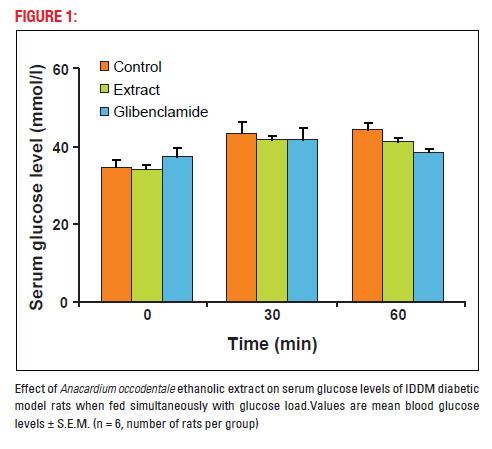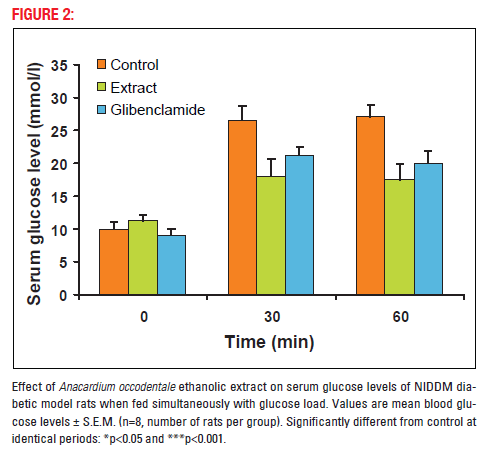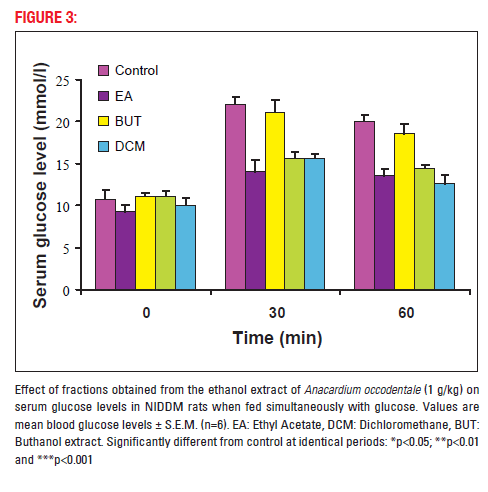Antihyperglycemic effect of ethanolic Extract and fractions of Anacardium Occidentale l. Stem bark in Streptozotocin-induced diabetic rats
- *Corresponding Author:
- Ramnik Singh
Khalsa College of Pharmacy, Amritsar-143002, Punjab, India
E-mail: ramnik1144@yahoo.co.in
Date of Received: 20-01-2010
Date of Modified: 29-01-2010
Date of Accepted: 02-02-2010
Available Online: 15-02-2010
Abstract
The numbers of adults with diabetes in the world is estimated to rise 300 millions in the year 2025 and this leads to increasing search for better anti-diabetic drug. The effects of the ethanol extract (1.25 g/kg) and fractions (Ethyl acetate, dichlo-romethane and butanol in the dose of 1 g/kg) of Anacardium occidentale stem bark on the blood glucose levels in streptozotocin-induced types 1 and 2 diabetic rats at different prandial states were studied. The ethanol extract of A. occidentale had no hypoglycemic effect in type 1 diabetic rats in fasting and postprandial glucose load conditions and, in type 2 diabetic rats in fasting condition. However, the extract, sig-nificantly lowered blood glucose levels in type 2 diabetic rats when fed simultane-ously with glucose. The ethyl acetate fraction showed a significant opposing effect in serum glucose rise after administration of glucose. Additionally, its dichloromethane extract also exhibited a significant reduction in serum glucose level compared to con-trol after glucose administration while its butanol fraction was devoid of this activity. These findings conclude that the active principles responsible for the antihyperglycae-mic effect might be concentrated in the ethyl acetate and dichloromethane fractions of the extract.
Keywords
Anacardium occidentale Non insulin dependent diabetes, streptozotocin
Introduction
The pathogenesis of diabetes mellitus and the possibility of its management by existing therapeutic agents without any side effects have stimulated great interest in recent years [1]. Few of plant treatments used in traditional medicine for diabetes have received scientific scrutiny, and the World Health Organization has recommended that this area warrant attention [2]. It has reported that aqueous extracts of Anacardium occidentale has antihyperglycemic effects [3]. Therefore the present work was undertaken to study the glucose-lowering effects of the ethanol extract and fractions of A. occidentale stem bark in streptozotocin-induced types 1 and 2 diabetic rats at different prandial states.
Materials and Methods
Animals
Swiss Albino (Wistar) rats of weight, 200–230 g, bred at animal house Sri Sai Institute of Pharmaceutical Education & Research (SSIPER), Badhani, Pathankot were used for this study. The animals were maintained on 12 hours light-dark cycle at room temperature, fed on a standard laboratory pellet diet and with water supplied ad libitum.
Plant Material
A. occidentale stem bark was collected from Badhani, Pathankot and identified by Dr. N.N. Sharma at (SSIPER), Badhani, Pathankot. Herbarium voucher specimen number SAI-76 has been deposited for reference in future. The bark was dried under sunlight and ground into powder.
Extraction procedure and Fractionation
A 2.5 kg powdered A. occidentale bark was extracted (4 times, 24 hours each time) with 80% ethanol at room temperature, filtered and concentrated. It is further freeze-dried to obtain a 200 g extract (8% w/w). The dried powder was suspended in water (500 ml) and then partitioned successively with CH2Cl2, EtOAc and 1-BuOH to give 12.92 g, 20.60 g and 30.82 g of extracts, respectively. The parent extract (80% EtOH) and its dichloromethane (DCM), ethyl acetate (EA), 1-butanol (BU) soluble parts were tested on IDDM and NIDDM model rats at different prandial states.
Effects on the fasting blood glucose levels.
Type 1 (IDDM) diabetes was induced by intraperitoneal injection of streptozotocin (stz, 65 mg/kg body weight) dissolved in citrate buffer (pH 4.5) immediately before use to 3 month old adult rats which were remain fasted for 18 hours. Type 2 diabetes (NIDDM) was induced by intraperitoneal injection of streptozotocin (90 mg/kg body weight) to 48- hour old pups rats as previously described by Bonner- Weir et al [4]. Groups of 6 to 8 rats each were used for the experiments. The ethanol extract of A. occidentale (1.25 g/kg body weight) were fed orally by gastric intubation to overnight fasting (12 hours) rats at 0 min and blood samples were drawn at 0, 60 and 120 min. Negative control group received only water (10 ml/kg body weight) and another group of rats received glibenclamide (5 mg/kg body weight) as a standard drug (Positive control group). The animals were kept unfed throughout the period.
Effects on blood glucose levels at concomitant administration of the fractions and glucose
The A. occidentale (1.25 g/kg body weight) extract and its fractions (1 g/kg body weight) were fed simultaneously with glucose (2.5 g/kg body weight) by gastric intubation to overnight fasting (12 hours) rats at 0 min and blood samples were drawn at 0, 30 and 60 min. Negative control group received only glucose (2.5 g/kg body weight) and the positive control group of rats received glibenclamide (5 mg/ kg body weight) along with glucose (2.5 g/kg body weight). The animals were kept unfed throughout the period.
Blood collection and biochemical analysis
Blood samples were collected from the tail tip under mild ether anesthesia. The serum was separated by centrifugation and the glucose level was measured immediately by digital glucometer (CT-X10, Elegance, Germany) with glucostix (Elegance, Germany).
Statistical analysis
Results were expressed as mean blood glucose levels ± S.E.M. Data were analyzed using One-way ANOVA followed by Dunnett’s test. The level of significance was set at 0.05.
Results
The ethanol extract of A. occidentale had no hypoglycemic effect in IDDM and NIDDM rats on fasting condition (Table 1). However, glibenclamide showed a significant (P<0.05) decrease of blood glucose levels in NIDDM rats on fasting state (36% and 38% reduction respectively 60 and 120 min after administration).
| Group | Blood glucose levels, mmol/l (percent of 0 min value) | ||
|---|---|---|---|
| 0 min | 60 min | 120 min | |
| A. IDDM model rats (n=6) | |||
| Control | 35.35 ± 1.30 | 31.97 ± 0.40 | 30.20 ± 1.37 |
| (100) | (91.12 ± 3.81) | (86.42 ± 6.13) | |
| Extract (1.25g/kg) | 34.46 ± 1.66 | 29.29 ± 1.77 | 29.22 ± 1.95 |
| (100) | (85.30 ± 4.20) | (85.20 ± 5.24) | |
| Glibenclamide (5 | 35.46 ± 1.21 | 35.46 ± 1.21 (100) | 28.73 ± 1.41 |
| mg/kg) | (100) | 35.46 ± 1.21 (100) | (82.15 ± 6.88) |
| B. NIDDM model rats (n=8) | |||
| Control | 9.45 ± 0.40 | 8.90 ± 0.36 | 9.97 ± 0.43 |
| (100) | (95.24 ± 5.10) | (107.38 ± 7.98) | |
| Extract (1.25g/kg) | 10.03 ± 0.41 | 8.88 ± 0.45 | 9.26 ± 0.33 |
| (100) | (89.96 ± 6.44) | (93.97 ± 6.59) | |
| Glibenclamide | 9.75 ± 0.42 | 6.24 ± 0.47*** | 6.02 ± 0.44*** |
| (5 mg/kg) | (100) | (64.34 ± 4.62)** | (61.70 ± 3.24)*** |
Values are mean blood glucose levels ± S.E.M. (n=number of rats per group). Significantly different from control at different periods: **p<0.01 and ***p<0.001
Table 1: Effect of Anacardium occodentale ethanolic extrac t on fas ting ser um glucose leve ls of IDDM and NIDDM diabetic model rats
Figure 1 shows the effect of A. occidentale 80% ethanol extract on postprandial blood glucose levels of IDDM rats when fed simultaneously with glucose (2.5 g/kg body weight). The extract showed a tendency to oppose the blood glucose rise but this effect was not significant compared to control (4% reduction 30 min after glucose load). Glibenclamide treated rats showed the same tendency.
However, in NIDDM diabetic model rats (Figure 2), the extract had a strong and significant (p<0.001) opposing effect on the rise of serum glucose level when fed simultaneously with glucose (32% and 35% inhibition of glucose rise respectively 30 and 60 min after glucose load). Glibenclamide also opposed the rise (20% inhibition, p<0.05) of serum glucose 30 min after simultaneous administration with glucose.
Figure 2: Effect of Anacardium occodentale ethanolic extract on serum glucose levels of NIDDM diabetic model rats when fed simultaneously with glucose load. Values are mean blood glucose levels ± S.E.M. (n=8, number of rats per group). Significantly different from control at identical periods: *p<0.05 and ***p<0.001.
As shown in Figure 3, the ethyl acetate fraction showed a significant (P<0.001) opposing effect in serum glucose rise 30 min after administration (36% inhibition of glucose rise compared to control rats, the ethyl acetate fraction showed a significant reduction (32%, P<0.01) of serum glucose level 75 min after simultaneous administration with glucose. The dichloromethane extract also showed a significant (P<0.05) reduction in serum glucose level compared to control (29% and 28% respectively 30 and 60 min after administration). In contrast, when compared to the control group, the butanol fraction was, however, devoid of this activity.
Figure 3: Effect of fractions obtained from the ethanol extract of Anacardium occodentale (1 g/kg) on serum glucose levels in NIDDM rats when fed simultaneously with glucose. Values are mean blood glucose levels ± S.E.M. (n=6). EA: Ethyl Acetate, DCM: Dichloromethane, BUT : Buthanol extract. Significantly different from control at identical periods: *p<0.05; **p<0.01 and ***p<0.001
Discussion
In adult animals, streptozotocin selectively destroys the pancreatic insulin-secreting β-cells, leaving less active cells and resulting in type 1 diabetic state [5-6]. Our results show that neither the 80% ethanol extract of A. occidentale nor glibenclamide demonstrated hypoglycemic or antihyperglycemic effects in IDDM rats in both fasting and glucose load states respectively. The main mechanism of action of glibenclamide is by the stimulation of insulin release. It has been described that glibenclamide is effective in moderate diabetic state, and ineffective in severe diabetic animals where pancreatic β-cells are almost totally destroyed [7-8]. The similar inactivity of the extract and glibenclamide may indicate that the extract also act by stimulation of the Islet cells and thus requires functional pancreatic β-cells for its action. This was confirmed by the inactivity of the extracts on fasted IDDM rats (Table 1). In the NIDDM diabetic model rats, the ethanol extract of A. occidentale showed an anytihyperglycemic effect comparable to that of glibenclamide when fed simultaneously with glucose. Thus, the extract may act on β-cells like sulfonylurea drugs to stimulate insulin secretion. As the ethanol extract of A. occidentale did not show any hypoglycemic effect in NIDDM rats on fasting condition, it can be assumed that this extract like tetraethyl ammonium (TEA), may stimulate insulin secretion in a glucose-dependent manner [9]. On the other hand, the hypoglycemic effect of the extract in the glucose-fed rats may be accounted in part, by an inhibition of intestinal glucose absorption and the stimulation of the glucagon-like peptide (GLP-1) which is also a glucose-dependent insulin secretagogue [10].
In this study, the ethyl acetate and dichloromethane fractions obtained from the ethanol extract, produced important hypoglycemic effects in NIDDM rats when fed simultaneously with glucose, indicating that the hypoglycemic components of the plant are concentrated in these two fractions. Further chemical and pharmacological investigations are in progress to elucidate in detail the active principles and the real mechanism of action of this plant extract.
References
- Bailey CJ. New pharmacological approaches to glycemic control. Diabetes Review, 1999; 7: 94-113.
- The WHO Expert Committee on Diabetes Mellitus. Technical Report Series 646, 1980. World Health Organization, Geneva pp 61.
- Sokeng DS, Kamtchouing P, Watcho P, et al. Hypoglycemic activity of Anacardium occidentale L. Aqueous extract in normal and streptozotocin-induced diabetic rats. Diabetes Res, 2001; 36: 001-009.
- Bonner-Weir S, Trent DF, Honey RN, et al. Responses of neonatal rat islets to streptozotocin: limited-cell regeneration and hyperglycemia. Diabetes, 1981; 30: 64-69.
- Ledoux SP, Woodley SE, Patton NJ, et al. Mechanism of notrosourea-induced β-cells damage-alterations in DNA. Diabetes, 1986; 35: 866-872.
- Kamtchouing P, Sokeng DS, Moundipa FP, et al. Protective role of Anacardium occidentale extract against streptozotocin-induced diabetes in rats. J Ethnopharmacol, 1998; 62: 95-99.
- Ivorra MD, Paya M, Villar A. A review of natural products and plants as potential antidiabetic drugs. J Ethnopharmacol, 1989; 27: 243-275.
- Suba V, Murugesan T, Bhaskara Rao R, et al. Antidiabetic potential of Barleria lupulina extract in rats. Fititerapia, 2004; 7: 1-4.
- MacDonald PE, Wheeler MB. Voltagedependent Potassium channels in pancreatic beta cells: Role, regulation and potential as therapeutic targets. Diabetologia, 2003; 46: 1046-1062.
- Goke B, Fuder H, Wieckhorst G, et al. Voglibose is an efficient α-glucosidase inhibitor and mobilizes the endogenous GLP-1 reserve. Digestion, 1995; 56: 493-501.




